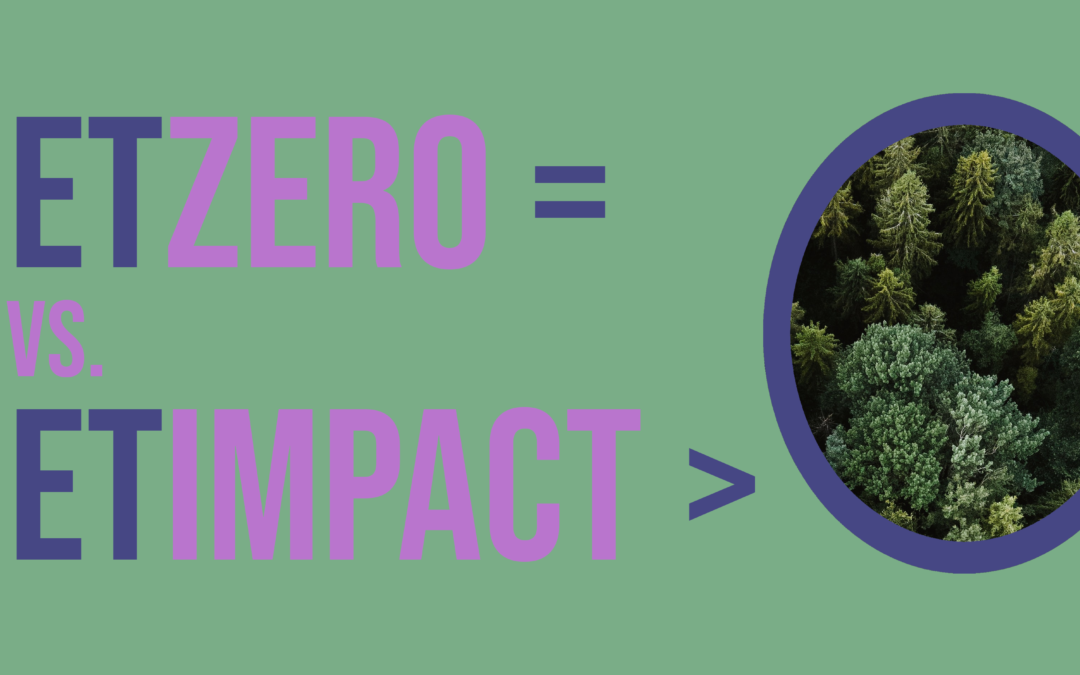Is a company with large CO2 emissions worse than a company with net-zero emissions? Not necessarily.
“Net-Zero” vs. “Net-Impact”
Net-zero means that one emits CO2, but an equal amount of CO2 is removed from the atmosphere. A typical example would be emitting CO2 from a factory while planting new trees that absorb it. Great.
Now let us imagine that a company pollutes quite significantly by using fossil fuels in the manufacturing process. At the same time let us assume that the products it manufactures help others reduce their emissions. An example would be insulating materials produced with fossil-fuel-based industrial processes. While it is true that the company emits large amounts of Greenhouse Gas Emissions (GHG), its products help reduce the emissions by buildings (homes, offices, industrial plants) because of lower heating needs.
If we focus on this example, scientific studies have been performed to estimate the environmental impact of such solutions, so we don’t only have (potentially biased) estimates by the insulating materials manufacturing companies themselves. A Spanish study [1] estimated environmental payback periods between 7 and 12 years, beyond which the energy savings and connected emission reductions compensate for the emissions from the manufacturing process. A Danish study [2] shows that (as usual) things are more complex than they seem, as there is a non-linear trade-off between insulation and heating emissions. Nevertheless, the impact of insulation materials is positive also in this study. So there is a solid basis to say that these businesses should have a net positive environmental impact, even if they are far from being net-zero companies, in the generally accepted sense of the expression.
Let us now completely change sector. We all know Ernst & Young. E&Y is one multinational boasting a carbon-negative balance – it is estimated that they offset more CO2 than they emit. Great, well done.
An important question
But now: what is a more environmentally sustainable investment, or even a stronger environmental impact investment?
- investing in a net-zero (or even carbon-negative) company like E&Y, or
- investing in companies that are carbon-positive (emit more CO2 than they remove) but whose products actually help the world reduce overall emissions – and even achieve better energy security?
Net-zero pledges have become such a powerful marketing tool. The message that is sent out is often “I promise that within 15 years I will plant so many trees that my environmental impact will be net zero. Hence, wow, I’m a really good (please take a nice picture) business”. The problem with this approach is that it measures only one component of actual impact – net GHG emissions by the business, adding (all or most) scope 1, 2 and 3 emissions and subtracting carbon sinks like “planting trees” strategies. In fact, we could argue that the insulation company has a real positive impact, while E&Y is in a sense just doing no direct harm to the environment. Net-zero is therefore not telling the whole story.
Cognitive biases
Psychologically, the “net-zero” (marketing) label introduces several psychological biases. When a metric becomes so popular (just look up “net-zero” in Google trends and see how much it increased recently), a representativeness bias arises – we believe that metric is a proxy for a company that is doing “good”. This in turn leads to an affect bias: “net-zero” (real or pledged) gives us a positive feeling, hence we perceive the company as good – and potentially less risky. If we focus on such a simplistic metric we introduce a selection bias – businesses that do not fulfil this criterion are screened out, filtered out, even when in fact, from a holistic point of view, they might have a stronger positive impact on the environment.
Why is that? Things are complex and humans don’t have time or are too lazy to analyse and compare. That’s why we use rules of thumbs, heuristics: net-zero good, non-net-zero boooooh very bad – that’s easy, how wonderful!
Does mining pollute? Yes. Are certain mines placed in countries with questionable (to say the least) protection for workers? Yes. Does a mining company therefore by default generate negative environmental and social impact? Not necessarily. Do we need certain metals to produce clean energy? Yes, unless we develop new technologies to an efficient scale very quickly. If a certain mining company sells its operations in a “difficult” country, will workers be better off? It depends on who buys and will operate that project. While these arguments cannot be used as excuses to operate in an unethical way, the question of positive or negative impact is more complex than what a ESG score or similar metrics may suggest.
The ultimate impact
Impact and sustainable have become trendy words. So trendy, that regulators around the world had to investigate certain sustainability claims. On the other side of the Atlantic, the US regulator SEC already fined a bank for ESG misstatements, while here in Europe the German regulator BaFin raided the offices of the asset management powerhouse DWS (which we obviously have to assume innocent until proven guilty). That is nevertheless a reminder that greenwashing is a real risk, for investors as well as managers and advisors. And for the world! Because if we can’t allocate capital where it truly makes an impact, the world loses, as nothing will change, or if it does so, it will be most likely too late.
Bibliography
[1] Llantoy, Noelia, Marta Chafer, and Luisa F. Cabeza. “A comparative life cycle assessment (LCA) of different insulation materials for buildings in the continental Mediterranean climate.” Energy and Buildings 225 (2020): 110323.
[2] Sohn, Joshua L., et al. “Life-cycle based dynamic assessment of mineral wool insulation in a Danish residential building application.” Journal of cleaner production 142 (2017): 3243-3253.

